The History Book Club discussion
HISTORY OF RELIGIONS
>
SIKHISM
date newest »
newest »
 newest »
newest »
Sikhism: A Very Short Introduction
 by Eleanor Nesbitt (no photo)
by Eleanor Nesbitt (no photo)
Synopsis:
The Sikh religion has a following of over 20 million people worldwide and is ranked as the world's fifth largest religion.
However, events such as the verbal and physical attacks on Sikhs just after September 11 indicated that they were being mistaken for Muslims, and suggests that the raising of sufficient and appropriate awareness about Sikhism still needs to be addressed.
This book is one of the first to introduce newcomers to Sikhism's meanings, beliefs, practices, rituals, and festivals. Eleanor Nesbitt highlights the key threads in the fascinating history, from the Gurus and the development of the Sikh appearance, to martyrdom and militarization in the 17th and 18th centuries, and the diaspora.
She also examines the recent proliferation of Sikh lifestyles in today's news and entertainment media. This book is an essential guide to increasing understanding of the Sikh religion and culture.
 by Eleanor Nesbitt (no photo)
by Eleanor Nesbitt (no photo)Synopsis:
The Sikh religion has a following of over 20 million people worldwide and is ranked as the world's fifth largest religion.
However, events such as the verbal and physical attacks on Sikhs just after September 11 indicated that they were being mistaken for Muslims, and suggests that the raising of sufficient and appropriate awareness about Sikhism still needs to be addressed.
This book is one of the first to introduce newcomers to Sikhism's meanings, beliefs, practices, rituals, and festivals. Eleanor Nesbitt highlights the key threads in the fascinating history, from the Gurus and the development of the Sikh appearance, to martyrdom and militarization in the 17th and 18th centuries, and the diaspora.
She also examines the recent proliferation of Sikh lifestyles in today's news and entertainment media. This book is an essential guide to increasing understanding of the Sikh religion and culture.
Overview of Sikhism
The word "Sikhism" derives from "Sikh," which means a strong and able disciple. There are about 23 million Sikhs worldwide, making Sikhism the 5th largest religion in the world. Approximately 19 million Sikhs live in India, primarily in the state of Punjab. Large populations of Sikhs can also be found in the United Kingdom, Canada, and the United States. Sikhs are a significant minority in Malaysia and Singapore, where they are sometimes ridiculed for their distinctive appearance, but respected for their work ethic and high education standards.
Sikhism emerged in 16th-century India in an environment heavily permeated with conflicts between the Hindu and Muslim religions. It was somewhat influenced by reform movements in Hinduism (e.g. Bhakti, monism, Vedic metaphysics, guru ideal, and bhajans) as well as some Sufi Muslim influences. While Sikhism reflects its cultural context, it certainly developed into a movement unique in India. Sikhs regard their faith as an authentic new divine revelation.
Sikhism was founded by Guru Nanak Dev, who was born in 1469 to a Hindu family. After four epic journeys (north to Tibet, south to Sri Lanka, east to Bengal and west to Mecca and Baghdad), Guru Nanak preached to Hindus, Muslims and others, and in the process attracted a following of Sikhs (disciples). Religion, he taught, was a way to unite people, but in practice he found that it set men against one another. He particularly regretted the antagonism between Hindus and Muslims. Guru Nanak's most famous saying is, "There is no Hindu, there is no Muslim, so whose path shall I follow? I shall follow the path of God."
Retaining the Hindu doctrine of the transmigration of souls, together with its corollary, the law of karma, Guru Nanak advised his followers to end the cycle of reincarnation by living a disciplined life – that is, by moderating egoism and sensuous delights, to live in a balanced worldly manner, and by accepting ultimate reality. Thus, by the grace of Guru (Gurprasad) the cycle of reincarnation can be broken, and the Sikh can remain in the abode of the Love of God. Guru Nanak taught that salvation does not mean entering paradise after a last judgment, but a union and absorption into God, the True Name. Sikhs do not believe in a heaven or hell. Sikhs also reject the Hindu belief in incarnations (avatars) of God, believing instead that God makes his will know through the Gurus.
The most easily observable Sikh practices are the wearing of the turban and the Five Ks. Sikhs also pray regularly and meditate by repeating God's name, often with the aid of rosary beads. Sikhism rejects the Hindu notion of the four stages of life, teaching instead that the householder is the ideal for all people. A Sikh aims to live a life that balances work, worship and charity. Community is emphasized, and the Sikh temple (gurdwara) is the center of Sikh communal life.
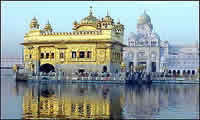
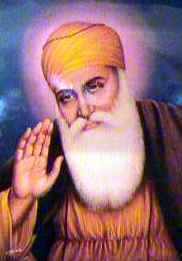
Its founder - Guru Nanak Dev
The word "Sikhism" derives from "Sikh," which means a strong and able disciple. There are about 23 million Sikhs worldwide, making Sikhism the 5th largest religion in the world. Approximately 19 million Sikhs live in India, primarily in the state of Punjab. Large populations of Sikhs can also be found in the United Kingdom, Canada, and the United States. Sikhs are a significant minority in Malaysia and Singapore, where they are sometimes ridiculed for their distinctive appearance, but respected for their work ethic and high education standards.
Sikhism emerged in 16th-century India in an environment heavily permeated with conflicts between the Hindu and Muslim religions. It was somewhat influenced by reform movements in Hinduism (e.g. Bhakti, monism, Vedic metaphysics, guru ideal, and bhajans) as well as some Sufi Muslim influences. While Sikhism reflects its cultural context, it certainly developed into a movement unique in India. Sikhs regard their faith as an authentic new divine revelation.
Sikhism was founded by Guru Nanak Dev, who was born in 1469 to a Hindu family. After four epic journeys (north to Tibet, south to Sri Lanka, east to Bengal and west to Mecca and Baghdad), Guru Nanak preached to Hindus, Muslims and others, and in the process attracted a following of Sikhs (disciples). Religion, he taught, was a way to unite people, but in practice he found that it set men against one another. He particularly regretted the antagonism between Hindus and Muslims. Guru Nanak's most famous saying is, "There is no Hindu, there is no Muslim, so whose path shall I follow? I shall follow the path of God."
Retaining the Hindu doctrine of the transmigration of souls, together with its corollary, the law of karma, Guru Nanak advised his followers to end the cycle of reincarnation by living a disciplined life – that is, by moderating egoism and sensuous delights, to live in a balanced worldly manner, and by accepting ultimate reality. Thus, by the grace of Guru (Gurprasad) the cycle of reincarnation can be broken, and the Sikh can remain in the abode of the Love of God. Guru Nanak taught that salvation does not mean entering paradise after a last judgment, but a union and absorption into God, the True Name. Sikhs do not believe in a heaven or hell. Sikhs also reject the Hindu belief in incarnations (avatars) of God, believing instead that God makes his will know through the Gurus.
The most easily observable Sikh practices are the wearing of the turban and the Five Ks. Sikhs also pray regularly and meditate by repeating God's name, often with the aid of rosary beads. Sikhism rejects the Hindu notion of the four stages of life, teaching instead that the householder is the ideal for all people. A Sikh aims to live a life that balances work, worship and charity. Community is emphasized, and the Sikh temple (gurdwara) is the center of Sikh communal life.


Its founder - Guru Nanak Dev
Facts and Stats on Sikhism
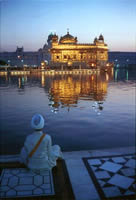
name
From Punjabi sikh, "learner" or "disciple"
founded
c. 1500 in India
founder
Shri Guru Nanak Dev Ji (1469-1538)
adherents
23 million
main location
Punjab region of India
original language
Punjabi
sacred text
Adi Granth (Sri Guru Granth Sahib)
spiritual leaders
Granthi, giani
house of worship
Temple, gurdwara
theism
monotheism
ultimate reality
God (Ik Onkar, Nam)
purpose of life
Overcome the self, align life with will of God, and become a "saint soldier," fighting for good
afterlife
Reincarnation until resolve karma and merge with God.
major holidays
Vaisakhi Day
Birthday of Guru Nanak
Birthday of Guru Gobind Singh
five cardinal vices
1. lust
2. anger
3. greed
4. worldly attachment
5. pride

name
From Punjabi sikh, "learner" or "disciple"
founded
c. 1500 in India
founder
Shri Guru Nanak Dev Ji (1469-1538)
adherents
23 million
main location
Punjab region of India
original language
Punjabi
sacred text
Adi Granth (Sri Guru Granth Sahib)
spiritual leaders
Granthi, giani
house of worship
Temple, gurdwara
theism
monotheism
ultimate reality
God (Ik Onkar, Nam)
purpose of life
Overcome the self, align life with will of God, and become a "saint soldier," fighting for good
afterlife
Reincarnation until resolve karma and merge with God.
major holidays
Vaisakhi Day
Birthday of Guru Nanak
Birthday of Guru Gobind Singh
five cardinal vices
1. lust
2. anger
3. greed
4. worldly attachment
5. pride
World Religions: The Great Faiths: Explored and Explained
 by John Bowker (no photo)
by John Bowker (no photo)
Synopsis:
Taking a refreshing new approach toward understanding different faiths, World Religions looks at the beliefs and practices of many different religions, including Christianity, Judaism, Hinduism, Buddhism, Jainism, Sikhism and Islam. Explained through detailed annotation of sacred texts, religious artifacts, paintings, and architecture, this book will engage the whole family
 by John Bowker (no photo)
by John Bowker (no photo)Synopsis:
Taking a refreshing new approach toward understanding different faiths, World Religions looks at the beliefs and practices of many different religions, including Christianity, Judaism, Hinduism, Buddhism, Jainism, Sikhism and Islam. Explained through detailed annotation of sacred texts, religious artifacts, paintings, and architecture, this book will engage the whole family
Timeline of Sikhism
1469 CE -- Birth of Guru Nanak in Pakistan.
c. 1499 -- Guru Nanak founds Sikhism
1574 -- Harimandir Sahib built
May 30, 1606 -- Torture and martyrdom of Guru Arjan Dev.
1666 -- Birth of Guru Gobind Singh
1675 -- Adi Granth compiled
April 13, 1699 -- Khalsa established
Oct. 7, 1708 -- Martyrdom of Guru Gobind Singh.
1716 -- Banda Singh Bahadur, Sikh military leader, executed with followers in Delhi.
1761 -- Sikhs take the capital city of Lahore, Pakistan from the Mughal governor
1799 -- Harimandir Sahib gilded with gold
1819 -- Ranjit Singh takes Kashmir
1849 -- Lord Dalhousie annexes Punjab into British India
1950 -- Rahit Maryada issued
June 1984 -- India storms Golden Temple. Several hundred Sikhs are killed and the Temple is extensively damaged.
Oct. 1984 -- Indira Gandhi assassinated by two Sikh bodyguards, leading to Hindu violence against Sikhs.
May 22, 2004 -- Manmohan Singh, a Sikh, is sworn in as the first non-Hindu Prime Minister of India
1469 CE -- Birth of Guru Nanak in Pakistan.
c. 1499 -- Guru Nanak founds Sikhism
1574 -- Harimandir Sahib built
May 30, 1606 -- Torture and martyrdom of Guru Arjan Dev.
1666 -- Birth of Guru Gobind Singh
1675 -- Adi Granth compiled
April 13, 1699 -- Khalsa established
Oct. 7, 1708 -- Martyrdom of Guru Gobind Singh.
1716 -- Banda Singh Bahadur, Sikh military leader, executed with followers in Delhi.
1761 -- Sikhs take the capital city of Lahore, Pakistan from the Mughal governor
1799 -- Harimandir Sahib gilded with gold
1819 -- Ranjit Singh takes Kashmir
1849 -- Lord Dalhousie annexes Punjab into British India
1950 -- Rahit Maryada issued
June 1984 -- India storms Golden Temple. Several hundred Sikhs are killed and the Temple is extensively damaged.
Oct. 1984 -- Indira Gandhi assassinated by two Sikh bodyguards, leading to Hindu violence against Sikhs.
May 22, 2004 -- Manmohan Singh, a Sikh, is sworn in as the first non-Hindu Prime Minister of India
The Cambridge Illustrated History of Religions
 by John Bowker (no photo)
by John Bowker (no photo)
Synopsis:
Grand in its sweep, this survey of the sacred writings of the major religions of the world offers a thoughtful introduction to the ideas and beliefs upon which great faiths are built. Under the expert guidance of John Bowker, a religious scholar and author of international stature, readers explore the key texts of Jewish, Christian, Muslim, Hindu, Jain, Sikh, Buddhist, Parsi, Confucian, Daoist, and Shinto traditions. The author discusses some 400 books, among them such well-known sacred texts as the Bible and the Quran, but also spiritual writings by theologians, philosophers, poets, and others.
Bowker provides clear and illuminating commentary on each text, describing the content and core tenets of the work and quoting pertinent passages. He also sets the writings in religious and historical contexts, showing how they have influenced—and in many cases continue to influence—artistic, musical, literary, and political traditions. The Message and the Book is essential reading for anyone who wishes to understand the meaning and the deep significance of primary religious texts of civilizations around the globe.
 by John Bowker (no photo)
by John Bowker (no photo)Synopsis:
Grand in its sweep, this survey of the sacred writings of the major religions of the world offers a thoughtful introduction to the ideas and beliefs upon which great faiths are built. Under the expert guidance of John Bowker, a religious scholar and author of international stature, readers explore the key texts of Jewish, Christian, Muslim, Hindu, Jain, Sikh, Buddhist, Parsi, Confucian, Daoist, and Shinto traditions. The author discusses some 400 books, among them such well-known sacred texts as the Bible and the Quran, but also spiritual writings by theologians, philosophers, poets, and others.
Bowker provides clear and illuminating commentary on each text, describing the content and core tenets of the work and quoting pertinent passages. He also sets the writings in religious and historical contexts, showing how they have influenced—and in many cases continue to influence—artistic, musical, literary, and political traditions. The Message and the Book is essential reading for anyone who wishes to understand the meaning and the deep significance of primary religious texts of civilizations around the globe.
History of Sikhism
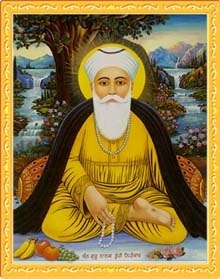
The Life of Guru Nanak
Guru Nanak (20 October 1469 - 7 May 1539) is the founder of Sikhism and the first of the ten Sikh Gurus. He was born in the village of Talwandi, now called Nankana Sahib, near Lahore in present-day Pakistan.
His parents, Mehta Kalu and Matta Tripat, were Hindus and belonged to the merchant caste. Even as a boy, Nanak was fascinated by religion, and his desire to explore the mysteries of life eventually led him to leave home.
Nanak married Sulkhni, of Batala, and they had two sons, Sri Chand and Lakhmi Das. His brother-in-law, the husband of his sister Nanki, obtained a job for him in Sultanpur as the manager of the government granary.
One morning, when he was 28, he went as usual down to the river to bathe and meditate. It was said that he was gone for three days. When he reappeared, filled with the spirit of God, he said, "There is no Hindu and no Muslim." It was then he began his missionary work.
Tradition states that he made four great journeys, traveling to all parts of India, and into Arabia and Persia; visiting Mecca and Baghdad. He spoke before Hindus, Jains, Buddhists, Parsees, and Muslims. He spoke in the temples and mosques, and at various pilgrimage sites. It was during this period that Nanak met Kabir (1441-1518), a saint revered by both Hindus and Muslims.
Wherever he went, Guru Nanak spoke out against empty religious rituals, pilgrimages, the caste system, the sacrifice of widows, of depending on books to learn the true religion, and of all the other tenets that were to define his teachings. Never did he ask his listeners to follow him. He asked the Muslims to be true Muslims and the Hindus to be true Hindus.
After the last of his great journeys, Guru Nanak settled in the town of Kartapur (in Punjab) on the banks of the Ravi where he taught for another fifteen years. Followers from all over came to settle in Kartapur to listen, and sing, and be with him. During this time, although his followers still remained Hindu, Muslim, or of the religion to which they were born, they became known as the Guru's disciples, or sikhs. It was here his followers began to refer to him as teacher, or guru.
It was here that the Guru told his followers that they were to be householders and could not live apart from the world—there were to be no priests or hermits. Here is where the Guru instituted the common meal; requiring the rich and poor, Hindu and Muslim, high caste and low cast, to sit together while eating. Here is where Lehna, later to be Guru Angad, came to be with Guru Nanak.
Just before Guru Nanak died, he called his disciples together and requested them to sing Sohila, the evening hymn. To satisfy both his Hindu and Muslim follower as to the funeral arrangements it is said he did not allow his body to remain behind.
The Ten Gurus
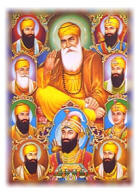
Sikhism was established and developed by ten Gurus during the period 1469 to 1708. Sikhs regard the ten Gurus not as divine, but as enlightened teachers through whom God revealed his will. Each Guru appointed his successor. Guru Nanak Dev was the first Guru and Guru Gobind Singh the final Guru in human form. Guru Gobind Singh designated the Sri Guru Granth Sahib the ultimate and final Sikh Guru.
The ten Gurus are:
1. Guru Nanak Dev (1469-1539). - The founder of Sikhism (see above).
2. Guru Angad Dev (1504-52). - Developed Gurmukhi, the script used for the Punjab language and composed 62 hymns that were later included in the Guru Granth Sahib.
3. Guru Amar Das (1479-1574). - Became Guru at the age of 73. Organized three annual gatherings for Sikhs, set up the first pilgrimage site at Goindval Sahib and introduced Sikh rituals for birth and death. His most famous hymn, Anand Sahib, is part of Sikh daily ritual.
4. Guru Ram Das (1534-1581). - Founded Amritsar, the holy city of Sikhism. His followers dug the pool that became the holy lake surrounding the Golden Temple. Composed the Lavan marriage hymn, still used in Sikh marriages.
5. Guru Arjan Dev (1563-1606). - Collected the hymns of previous Gurus and added 2616 of his own to form the Guru Granth Sahib, the holy book of Sikhism. He also built the Golden Temple.
6. Guru Hargobind (1595-1644). - The son of Guru Arjan. Proclaimed that the Guru is a military leader as well as spiritual leader, leading to conflict with the Mughal emperor Shah Jahan.
7. Guru Har Rai (1630-1661). -- Grandson of Guru Hargobind.
8. Guru Har Krishan (1656-1664). -- Younger son of Guru Har Rai. Became guru at the age of 5 and died of smallpox at the age of 8. He is the only Guru depicted in art without a beard.
9. Guru Tegh Bahadur (1621-75) -- . Great-uncle of Guru Har Krishan. Was barred from Amritsar by Sikh rivals, so founded the Sikh center of Anandpur. Was beheaded in Delhi by Muslims for helping Brahmins avoid forcible conversion to Islam.
10. Guru Gobind Singh (1666-1708). -- Son of Guru Tegh Bahadur. Second only to Guru Nanak in importance, he is often shown prominently next to Nanak in Sikh art. Resisted oppression by Muhgal and Hindu authorities, exemplifying the Sikh ideal of the heroic saint-soldier. Founded the Khalsa and Sikh baptism, composed many poems, and nominated the Sikh sacred text as the final and enduring Guru.

The Life of Guru Nanak
Guru Nanak (20 October 1469 - 7 May 1539) is the founder of Sikhism and the first of the ten Sikh Gurus. He was born in the village of Talwandi, now called Nankana Sahib, near Lahore in present-day Pakistan.
His parents, Mehta Kalu and Matta Tripat, were Hindus and belonged to the merchant caste. Even as a boy, Nanak was fascinated by religion, and his desire to explore the mysteries of life eventually led him to leave home.
Nanak married Sulkhni, of Batala, and they had two sons, Sri Chand and Lakhmi Das. His brother-in-law, the husband of his sister Nanki, obtained a job for him in Sultanpur as the manager of the government granary.
One morning, when he was 28, he went as usual down to the river to bathe and meditate. It was said that he was gone for three days. When he reappeared, filled with the spirit of God, he said, "There is no Hindu and no Muslim." It was then he began his missionary work.
Tradition states that he made four great journeys, traveling to all parts of India, and into Arabia and Persia; visiting Mecca and Baghdad. He spoke before Hindus, Jains, Buddhists, Parsees, and Muslims. He spoke in the temples and mosques, and at various pilgrimage sites. It was during this period that Nanak met Kabir (1441-1518), a saint revered by both Hindus and Muslims.
Wherever he went, Guru Nanak spoke out against empty religious rituals, pilgrimages, the caste system, the sacrifice of widows, of depending on books to learn the true religion, and of all the other tenets that were to define his teachings. Never did he ask his listeners to follow him. He asked the Muslims to be true Muslims and the Hindus to be true Hindus.
After the last of his great journeys, Guru Nanak settled in the town of Kartapur (in Punjab) on the banks of the Ravi where he taught for another fifteen years. Followers from all over came to settle in Kartapur to listen, and sing, and be with him. During this time, although his followers still remained Hindu, Muslim, or of the religion to which they were born, they became known as the Guru's disciples, or sikhs. It was here his followers began to refer to him as teacher, or guru.
It was here that the Guru told his followers that they were to be householders and could not live apart from the world—there were to be no priests or hermits. Here is where the Guru instituted the common meal; requiring the rich and poor, Hindu and Muslim, high caste and low cast, to sit together while eating. Here is where Lehna, later to be Guru Angad, came to be with Guru Nanak.
Just before Guru Nanak died, he called his disciples together and requested them to sing Sohila, the evening hymn. To satisfy both his Hindu and Muslim follower as to the funeral arrangements it is said he did not allow his body to remain behind.
The Ten Gurus

Sikhism was established and developed by ten Gurus during the period 1469 to 1708. Sikhs regard the ten Gurus not as divine, but as enlightened teachers through whom God revealed his will. Each Guru appointed his successor. Guru Nanak Dev was the first Guru and Guru Gobind Singh the final Guru in human form. Guru Gobind Singh designated the Sri Guru Granth Sahib the ultimate and final Sikh Guru.
The ten Gurus are:
1. Guru Nanak Dev (1469-1539). - The founder of Sikhism (see above).
2. Guru Angad Dev (1504-52). - Developed Gurmukhi, the script used for the Punjab language and composed 62 hymns that were later included in the Guru Granth Sahib.
3. Guru Amar Das (1479-1574). - Became Guru at the age of 73. Organized three annual gatherings for Sikhs, set up the first pilgrimage site at Goindval Sahib and introduced Sikh rituals for birth and death. His most famous hymn, Anand Sahib, is part of Sikh daily ritual.
4. Guru Ram Das (1534-1581). - Founded Amritsar, the holy city of Sikhism. His followers dug the pool that became the holy lake surrounding the Golden Temple. Composed the Lavan marriage hymn, still used in Sikh marriages.
5. Guru Arjan Dev (1563-1606). - Collected the hymns of previous Gurus and added 2616 of his own to form the Guru Granth Sahib, the holy book of Sikhism. He also built the Golden Temple.
6. Guru Hargobind (1595-1644). - The son of Guru Arjan. Proclaimed that the Guru is a military leader as well as spiritual leader, leading to conflict with the Mughal emperor Shah Jahan.
7. Guru Har Rai (1630-1661). -- Grandson of Guru Hargobind.
8. Guru Har Krishan (1656-1664). -- Younger son of Guru Har Rai. Became guru at the age of 5 and died of smallpox at the age of 8. He is the only Guru depicted in art without a beard.
9. Guru Tegh Bahadur (1621-75) -- . Great-uncle of Guru Har Krishan. Was barred from Amritsar by Sikh rivals, so founded the Sikh center of Anandpur. Was beheaded in Delhi by Muslims for helping Brahmins avoid forcible conversion to Islam.
10. Guru Gobind Singh (1666-1708). -- Son of Guru Tegh Bahadur. Second only to Guru Nanak in importance, he is often shown prominently next to Nanak in Sikh art. Resisted oppression by Muhgal and Hindu authorities, exemplifying the Sikh ideal of the heroic saint-soldier. Founded the Khalsa and Sikh baptism, composed many poems, and nominated the Sikh sacred text as the final and enduring Guru.
Beliefs and Doctrines of Sikhism
Religious Authority
The ultimate source of authority and doctrine in Sikhism is the sacred book, the Adi Granth. In the event of disputes, a council is convened at the Akal Takht ("Throne of the Timeless"), a building facing the Harimandir temple in Amritsar. Resolutions passed by this council carry spiritual sanction.
God
Sikhism is monotheistic, strongly emphasizing belief in one true God. Guru Nanak used the Hindu mystic syllable om as a symbol of God. He added the qualifications of God as one and creator, resulting in the ik om kar symbol. Sikhism forbids the representation of God in images and the worship of idols.
Karma and Reincarnation
Sikhism retains the general Hindu conception of the universe and the doctrine of samsara, or rebirth, based on karma. Human birth is the only chance to escape samsara and attain salvation.
Khalsa and State
Especially after conflict with the Mughal empire in Sikh history, religion and politics have been closely associated in Sikhism. Establishment of a Sikh state is a matter of religious doctrine, and all services end with the chant, "Raj karey Ga Khalsa" (the Khalsa shall rule).
 by Lambert M. Surhone (no photo)
by Lambert M. Surhone (no photo)
Religious Authority
The ultimate source of authority and doctrine in Sikhism is the sacred book, the Adi Granth. In the event of disputes, a council is convened at the Akal Takht ("Throne of the Timeless"), a building facing the Harimandir temple in Amritsar. Resolutions passed by this council carry spiritual sanction.
God
Sikhism is monotheistic, strongly emphasizing belief in one true God. Guru Nanak used the Hindu mystic syllable om as a symbol of God. He added the qualifications of God as one and creator, resulting in the ik om kar symbol. Sikhism forbids the representation of God in images and the worship of idols.
Karma and Reincarnation
Sikhism retains the general Hindu conception of the universe and the doctrine of samsara, or rebirth, based on karma. Human birth is the only chance to escape samsara and attain salvation.
Khalsa and State
Especially after conflict with the Mughal empire in Sikh history, religion and politics have been closely associated in Sikhism. Establishment of a Sikh state is a matter of religious doctrine, and all services end with the chant, "Raj karey Ga Khalsa" (the Khalsa shall rule).
 by Lambert M. Surhone (no photo)
by Lambert M. Surhone (no photo)
Sikh Holidays and Festivals

"The 12 months, the seasons, the dates, and all the days are blessed: each hour, minute, second leads naturally to the True One: meeting the Beloved, all one's deeds reach their purpose and fulfillment."
--Guru Granth Sahib
The most important holidays in Sikhism are gurpurbs, festivals marking the birthday or martyrdom of a Guru. Other holidays are melas or fairs.
Most Sikh holidays are celebrated with a ritual 48-hour reading of the entire Guru Granth Sahib, processions (see above), preaching, prayer, and congregational worship.
This article provides brief overviews of major Sikh holidays, in chronological order on the Western calendar.
Guru Gobind Singh's Birthday - January 5
Guru Gobind Singh, the tenth Guru, was born in 1666. His birthday is celebrated in December or January. Guru Gobind Singh founded the Khalsa and nominated the Guru Granth Sahib, the holy book, as his successor Guru.
Maghi - January 14
Maghi commemorates the martyrdom of the "Forty Immortals," forty followers of Guru Gobind Singh who had previously deserted him, fought bravely against overwhelming Mughal army forces and were martyred in Muktsar. Guru Gobind Singh blessed them as having achieved mukti (liberation) and cremated them at Muktsar. On Maghi, Sikhs visit gurdwaras and listen to kirtan (hymns). Naturally, the largest gathering is at Muktsar where an annual fair is held.
Hola Maholla - March 26

Hola (or Holla) Maholla is a mela celebrated in Anandpur on the Indian festival of Holi in memory of Guru Gobind Singh. The Guru instituted this day for military exercises and mock battles, followed by music and poetry contests. The holiday is still celebrated with mock battles and displays of horsemanship and skills with the sword. There are also processions with the Sikh flag and the Guru Granth Sahib.
Vaisakhi - April 14
Vaisakhi, in April, began as a Hindu festival of thankgiving but for Sikhs, marks the founding of the Khalsa in 1699. Those ready to be initiated into the Khalsa are usually baptized on this day, and the Sikh flag is replaced.
Martyrdom of Guru Arjan - June 16
Guru Arjan, the fifth Guru, was tortured and killed by the Mughal emperor Jahangir in 1606. His martyrdom is commemorated in May.
Celebration of the Guru Granth Sahib - September
This festival, celebrated in August or September, commemorates the completion of the Sikh holy text in 1606.
Diwali - Varies
Diwali is a Hindu festival of lights that was appropriated by the Sikhs to celebrate the release from prison of Guru Hargobind, the sixth Guru, from prison in 1619. The Golden Temple was illuminated with lights to welcome the Guru home, and Sikhs continue this tradition by lighting lamps on Diwali each year. The Golden Temple is illuminated with thousands of lights.
Guru Nanak's Birthday - November 15
Also in October is Guru Nanak's birthday celebration. He was born in 1469 in modern-day Pakistan.
Martyrdom of Guru Tegh Bahadur - November 24
Guru Tegh Bahadur, the ninth Guru, was executed in November 1675 by the emperor Aurangzeb.

"The 12 months, the seasons, the dates, and all the days are blessed: each hour, minute, second leads naturally to the True One: meeting the Beloved, all one's deeds reach their purpose and fulfillment."
--Guru Granth Sahib
The most important holidays in Sikhism are gurpurbs, festivals marking the birthday or martyrdom of a Guru. Other holidays are melas or fairs.
Most Sikh holidays are celebrated with a ritual 48-hour reading of the entire Guru Granth Sahib, processions (see above), preaching, prayer, and congregational worship.
This article provides brief overviews of major Sikh holidays, in chronological order on the Western calendar.
Guru Gobind Singh's Birthday - January 5
Guru Gobind Singh, the tenth Guru, was born in 1666. His birthday is celebrated in December or January. Guru Gobind Singh founded the Khalsa and nominated the Guru Granth Sahib, the holy book, as his successor Guru.
Maghi - January 14
Maghi commemorates the martyrdom of the "Forty Immortals," forty followers of Guru Gobind Singh who had previously deserted him, fought bravely against overwhelming Mughal army forces and were martyred in Muktsar. Guru Gobind Singh blessed them as having achieved mukti (liberation) and cremated them at Muktsar. On Maghi, Sikhs visit gurdwaras and listen to kirtan (hymns). Naturally, the largest gathering is at Muktsar where an annual fair is held.
Hola Maholla - March 26

Hola (or Holla) Maholla is a mela celebrated in Anandpur on the Indian festival of Holi in memory of Guru Gobind Singh. The Guru instituted this day for military exercises and mock battles, followed by music and poetry contests. The holiday is still celebrated with mock battles and displays of horsemanship and skills with the sword. There are also processions with the Sikh flag and the Guru Granth Sahib.
Vaisakhi - April 14
Vaisakhi, in April, began as a Hindu festival of thankgiving but for Sikhs, marks the founding of the Khalsa in 1699. Those ready to be initiated into the Khalsa are usually baptized on this day, and the Sikh flag is replaced.
Martyrdom of Guru Arjan - June 16
Guru Arjan, the fifth Guru, was tortured and killed by the Mughal emperor Jahangir in 1606. His martyrdom is commemorated in May.
Celebration of the Guru Granth Sahib - September
This festival, celebrated in August or September, commemorates the completion of the Sikh holy text in 1606.
Diwali - Varies
Diwali is a Hindu festival of lights that was appropriated by the Sikhs to celebrate the release from prison of Guru Hargobind, the sixth Guru, from prison in 1619. The Golden Temple was illuminated with lights to welcome the Guru home, and Sikhs continue this tradition by lighting lamps on Diwali each year. The Golden Temple is illuminated with thousands of lights.
Guru Nanak's Birthday - November 15
Also in October is Guru Nanak's birthday celebration. He was born in 1469 in modern-day Pakistan.
Martyrdom of Guru Tegh Bahadur - November 24
Guru Tegh Bahadur, the ninth Guru, was executed in November 1675 by the emperor Aurangzeb.
Diwali
Diwali (Sanskrit Dīpãvali, "row of lights"), also transliterated Deepavali or Diwãli (contracted spelling) is a Hindu festival of lights lasting five days. For many Hindus, Diwali is also New Year's Eve.

Lighting Diwali Candles
Diwali (Sanskrit Dīpãvali, "row of lights"), also transliterated Deepavali or Diwãli (contracted spelling) is a Hindu festival of lights lasting five days. For many Hindus, Diwali is also New Year's Eve.

Lighting Diwali Candles
Dates of Diwali
The Hindu calendar is a lunar calendar, with most years consisting of 12 lunar cycles and an extra month inserted approximately every seven years to resynchronize the calendar with the seasons.
On the Hindu calendar, Diwali is celebrated for the five days from the 13th day of the dark half of the lunar month Ashvina to the second day of the light half of Karttika.
On the Gregorian (western) calendar, Dipavali falls in the months of October or November, and always on a new moon day. Since the precise moment of the new moon falls on different Gregorian dates depending on geographical location, the date of Dipavali can also depend on one's location.
Specific dates for Diwali (the main, fourth day on the North Indian calendar) are as follows:
November 9 , 2007
October 28, 2008
October 17, 2009
November 5, 2010
October 26, 2011
November 13, 2012
November 3, 2013
October 23, 2014
November 11, 2015
October 30, 2016

Diwali Oil Lamps
The Hindu calendar is a lunar calendar, with most years consisting of 12 lunar cycles and an extra month inserted approximately every seven years to resynchronize the calendar with the seasons.
On the Hindu calendar, Diwali is celebrated for the five days from the 13th day of the dark half of the lunar month Ashvina to the second day of the light half of Karttika.
On the Gregorian (western) calendar, Dipavali falls in the months of October or November, and always on a new moon day. Since the precise moment of the new moon falls on different Gregorian dates depending on geographical location, the date of Dipavali can also depend on one's location.
Specific dates for Diwali (the main, fourth day on the North Indian calendar) are as follows:
November 9 , 2007
October 28, 2008
October 17, 2009
November 5, 2010
October 26, 2011
November 13, 2012
November 3, 2013
October 23, 2014
November 11, 2015
October 30, 2016

Diwali Oil Lamps

Diwali Display in Hotel
Meaning and Rituals of Diwali
Diwali is celebrated with a variety of rituals, which depend in large part on one's location, but they center on the lighting of candles, electric lights and fireworks.
The “row of lights” for which the festival is named are lit on the new-moon night to welcome Lakshmi, the goddess of wealth. But in Bengal, it is the goddess Kali who is so honored, and in North India the festival also celebrates the return of Rama, Sita, Lakshmana, and Hanuman to the city of Ayodhya, where Rama's rule of righteousness was inaugurated.
Throughout the five-day festival, small earthenware lamps filled with oil are lighted and placed in rows along the tops of temples and houses and set adrift on rivers and streams.
Gambling is encouraged during the Diwali season as a way of ensuring good luck for the coming year and in remembrance of the games of dice played by the Lord Shiva and Parvati on Mount Kailasa or between Radha and Krishna. In honour of Lakshmi, the female player always wins during Diwali.
The fourth day — the main day of Diwali and the beginning of the lunar month of Karttika — marks the beginning of the new year according to the Vikrama calendar. On this day, merchants perform religious ceremonies and open new account books. It is generally a time for visiting, exchanging gifts, cleaning and decorating houses, feasting, setting off fireworks displays, and wearing new clothes.
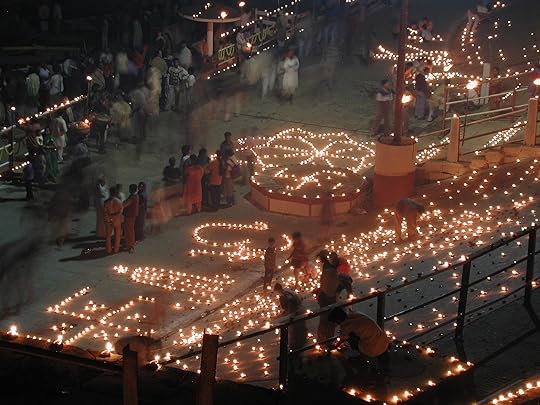
Diwali lights in Varanasi
Regional Variation
In South India, which uses the Shalivahana calendar, Diwali does not coincide with the beginning of a new year. In South India, the new year (Ugadi), is followed by persons in Andhra Pradesh and Karnataka. Vishu and Varsha Pirappu are celebrated in Kerala and Tamil Nadu respectively. These festivals occur at about the same time, generally during April.
In England, the days are Dhanteras, Narak Chatrudashi, Lakshmi-Puja, the most important day, Padwa or Varshapratipanda and Bhaiya Dooj or the Teeka Ceremony
In Trinidad and Tobago, the day of Divali is a public holiday and celebrations precede the Lakshmi-Puja day for almost two weeks. This event is one of the foremost religious observances for the country.

Mangalore temples at Diwali. Photo: David G

Diwali fireworks. Photo: Sumith Meher.
Diwali in Other Religions
The Diwali season is also significant to Sikhs. During the festival time in 1620, the sixth Guru, Hargobind Singh, gained the release of 52 Hindu princes who had been falsely imprisoned in Gwallior Fort by the rulers of the area, the Mughals. The Golden Temple of Amritsar was lit with many lights to welcome the release of Guru Hargobind; Sikhs have continued the tradition.
Jains also celebrate Diwali, as a celebration of the establishment of the dharma by Lord Mahavira. The festival's lights symbolizes the light of holy knowledge that was extinguished with Mahavira's passing.

Earthenware Diwali lamp. Photo: teraroop11

Building in Hyderabad at Diwali. Photo: TigerPuppal
Sikh Things: Sacred and Ceremonial Objects

Guru Granth Sahib
Guru Granth Sahib
The most sacred object in Sikhism is the Guru Granth Sahib (also called the Adi Granth), the Sikh holy book. Unlike the New Testament or the Bhagavad-Gita, which are often carried around, dog-eared and placed on a shelf with other books, there are strict rules and procedures for handling the Adi Granth. For this reason, most Sikhs keep a smaller manual at home containing the main passages from the Adi Granth used in daily prayers.
The tenth and last human Guru, Guru Gobind Singh, designated as his successor the holy book of Sikhism as the enduring and living Guru. Accordingly, the Guru Granth Sahib is treated with the same respect one would show a human Guru.
The Guru Granth Sahib is kept under a canopy and on a throne, covered in decorative cloths (rumalas) at night, and a chauri (whisk) is waved over it while it is being read. When entering the presence of the Guru Granth Sahib, one must be barefoot, have his or her head covered, and prostrate before the book. When moved, the book is wrapped in cloth and carried on someone's head as a sign of its honored status.
The Adi Granth is printed in Gurmukhi script, a form of Hindi dating to the middle ages. The pages often have ornate decorations, but it is a fundamental principle of the Sikh faith that Truth is much more important than ritual and only what is written in the book really matters.

Guru Granth Sahib
Guru Granth Sahib
The most sacred object in Sikhism is the Guru Granth Sahib (also called the Adi Granth), the Sikh holy book. Unlike the New Testament or the Bhagavad-Gita, which are often carried around, dog-eared and placed on a shelf with other books, there are strict rules and procedures for handling the Adi Granth. For this reason, most Sikhs keep a smaller manual at home containing the main passages from the Adi Granth used in daily prayers.
The tenth and last human Guru, Guru Gobind Singh, designated as his successor the holy book of Sikhism as the enduring and living Guru. Accordingly, the Guru Granth Sahib is treated with the same respect one would show a human Guru.
The Guru Granth Sahib is kept under a canopy and on a throne, covered in decorative cloths (rumalas) at night, and a chauri (whisk) is waved over it while it is being read. When entering the presence of the Guru Granth Sahib, one must be barefoot, have his or her head covered, and prostrate before the book. When moved, the book is wrapped in cloth and carried on someone's head as a sign of its honored status.
The Adi Granth is printed in Gurmukhi script, a form of Hindi dating to the middle ages. The pages often have ornate decorations, but it is a fundamental principle of the Sikh faith that Truth is much more important than ritual and only what is written in the book really matters.
Sikh Things: Sacred and Ceremonial Objects

Chauri
Chauri
As mentioned above, a whisk is waved over the Guru Granth Sahib whenever it is read. This whisk is caleld a chauri and is usually made of yak tail hair or artificial fiber, set in a wooden or metal holder. The use of the chauri derives from the practice of retainers keeping dignitaries cool with a whisk or fan, which became a symbol of sovereignty and honor.

Chauri
Chauri
As mentioned above, a whisk is waved over the Guru Granth Sahib whenever it is read. This whisk is caleld a chauri and is usually made of yak tail hair or artificial fiber, set in a wooden or metal holder. The use of the chauri derives from the practice of retainers keeping dignitaries cool with a whisk or fan, which became a symbol of sovereignty and honor.
Sikh Things: Sacred and Ceremonial Objects
Five Ks
When Guru Gobind Singh established the Khalsa in 1699, he asked all Sikhs to wear five symbols expressing their allegiance to the new Sikh community. These five symbols are known as the five Ks.
1. Kesh is uncut hair on the head and body, symbolizing acceptance of God's will. This gave rise to the distinctive Sikh turban, which arose as a way to keep the long hair clean and tidy.
2. Kachh is a pair of white cotton shorts worn as an undergarment. It is practical in battle, and therefore symbolizes moral strength and chastity.

Kachh
Five Ks
When Guru Gobind Singh established the Khalsa in 1699, he asked all Sikhs to wear five symbols expressing their allegiance to the new Sikh community. These five symbols are known as the five Ks.
1. Kesh is uncut hair on the head and body, symbolizing acceptance of God's will. This gave rise to the distinctive Sikh turban, which arose as a way to keep the long hair clean and tidy.
2. Kachh is a pair of white cotton shorts worn as an undergarment. It is practical in battle, and therefore symbolizes moral strength and chastity.

Kachh
Empath: 3 Manuscripts: Empath: The Ultimate Guide to Understanding and Embracing Your Gift, Empath: Meditation Techniques to shield your body, ... Relationships (Empath Series, Volume 4)
Not in Goodreads - on Amazon
Ryan James is an author who's passionate about Cognitive Psychology, Developmental Psychology, and Social Psychology.
He believes that by understanding our brain and our emotions, why we do what we do, we are better equipped to deal with the various challenges we encounter in life.
In his books, Ryan provides practical steps to improve all aspects of your life including, health, fitness, work, productivity, confidence, relationships and more. He focuses on providing actionable steps rather than hyped up strategies that rarely work in the real-world. you'll find that his books are easy to follow and easy to implement.
When he's not helping his clients become the best version of themselves, you will either find him at the rock climbing gym or at home with his family making his favorite guacamole recipe.
Not in Goodreads - on Amazon
Ryan James is an author who's passionate about Cognitive Psychology, Developmental Psychology, and Social Psychology.
He believes that by understanding our brain and our emotions, why we do what we do, we are better equipped to deal with the various challenges we encounter in life.
In his books, Ryan provides practical steps to improve all aspects of your life including, health, fitness, work, productivity, confidence, relationships and more. He focuses on providing actionable steps rather than hyped up strategies that rarely work in the real-world. you'll find that his books are easy to follow and easy to implement.
When he's not helping his clients become the best version of themselves, you will either find him at the rock climbing gym or at home with his family making his favorite guacamole recipe.
Engaging Japanese Philosophy: A Short History (Nanzan Library of Asian Religion and Culture)
 by Thomas P Kasulis (no photo
by Thomas P Kasulis (no photo
Synopsis:
Philosophy challenges our assumptions―especially when it comes to us from another culture. In exploring Japanese philosophy, a dependable guide is essential. The present volume, written by a renowned authority on the subject, offers readers a historical survey of Japanese thought that is both comprehensive and comprehensible.
Adhering to the Japanese philosophical tradition of highlighting engagement over detachment, Thomas Kasulis invites us to think with, as well as about, the Japanese masters by offering ample examples, innovative analogies, thought experiments, and jargon-free explanations. He assumes little previous knowledge and addresses themes―aesthetics, ethics, the samurai code, politics, among others―not in a vacuum but within the conditions of Japan’s cultural and intellectual history. For readers new to Japanese studies, he provides a simplified guide to pronouncing Japanese and a separate discussion of the language and how its syntax, orthography, and linguistic layers can serve the philosophical purposes of a skilled writer and subtle thinker. For those familiar with the Japanese cultural tradition but less so with philosophy, Kasulis clarifies philosophical expressions and problems, Western as well as Japanese, as they arise.
Half of the book’s chapters are devoted to seven major thinkers who collectively represent the full range of Japan’s historical epochs and philosophical traditions: Kūkai, Shinran, Dōgen, Ogyū Sorai, Motoori Norinaga, Nishida Kitarō, and Watsuji Tetsurō. Nuanced details and analyses enable an engaged understanding of Japanese Buddhism, Confucianism, Shintō, and modern academic philosophy. Other chapters supply social and cultural background, including brief discussions of nearly a hundred other philosophical writers. (For additional information, cross references to material in the companion volume Japanese Philosophy: A Sourcebook are included.) In his closing chapter Kasulis reflects on lessons from Japanese philosophy that enhance our understanding of philosophy itself. He reminds us that philosophy in its original sense means loving wisdom, not studying ideas. In that regard, a renewed appreciation of engaged knowing can play a critical role in the revitalization of philosophy in the West as well as the East.
 by Thomas P Kasulis (no photo
by Thomas P Kasulis (no photoSynopsis:
Philosophy challenges our assumptions―especially when it comes to us from another culture. In exploring Japanese philosophy, a dependable guide is essential. The present volume, written by a renowned authority on the subject, offers readers a historical survey of Japanese thought that is both comprehensive and comprehensible.
Adhering to the Japanese philosophical tradition of highlighting engagement over detachment, Thomas Kasulis invites us to think with, as well as about, the Japanese masters by offering ample examples, innovative analogies, thought experiments, and jargon-free explanations. He assumes little previous knowledge and addresses themes―aesthetics, ethics, the samurai code, politics, among others―not in a vacuum but within the conditions of Japan’s cultural and intellectual history. For readers new to Japanese studies, he provides a simplified guide to pronouncing Japanese and a separate discussion of the language and how its syntax, orthography, and linguistic layers can serve the philosophical purposes of a skilled writer and subtle thinker. For those familiar with the Japanese cultural tradition but less so with philosophy, Kasulis clarifies philosophical expressions and problems, Western as well as Japanese, as they arise.
Half of the book’s chapters are devoted to seven major thinkers who collectively represent the full range of Japan’s historical epochs and philosophical traditions: Kūkai, Shinran, Dōgen, Ogyū Sorai, Motoori Norinaga, Nishida Kitarō, and Watsuji Tetsurō. Nuanced details and analyses enable an engaged understanding of Japanese Buddhism, Confucianism, Shintō, and modern academic philosophy. Other chapters supply social and cultural background, including brief discussions of nearly a hundred other philosophical writers. (For additional information, cross references to material in the companion volume Japanese Philosophy: A Sourcebook are included.) In his closing chapter Kasulis reflects on lessons from Japanese philosophy that enhance our understanding of philosophy itself. He reminds us that philosophy in its original sense means loving wisdom, not studying ideas. In that regard, a renewed appreciation of engaged knowing can play a critical role in the revitalization of philosophy in the West as well as the East.
Warrior Saints: Four Centuries of Sikh Military History: Volume 2
 by Amandeep Singh Madra (no photo)
by Amandeep Singh Madra (no photo)
Synopsis:
When the Mughal Empire began persecuting the Sikhs in the 1600s, this community of North Indian devotees was forced to take up arms or face extinction.
Warrior Saints (Vol. 1) compellingly told the remarkable story of how they fought back to establish a powerful modern-day empire, stretching from the borders of Tibet to Afghanistan, which they then lost to the Honourable East India Company in two of its toughest 19th-century military conflicts.
Warrior Saints (Vol. 2) continues that fascinating story. The British were so impressed by the military prowess of their conquered foe – representing a curious mix of ancient Indian warfare combined with modern Napoleonic methods – they recruited Sikhs into Queen Victoria’s Indian Army.
Initially mobilised to protect the borders and outposts of the British Empire in distant lands including China, Ethiopia, Somaliland, Cyprus, Afghanistan, Egypt and Burma, thousands of Sikhs went on to lay down their lives in the Two World Wars. With the emergence of an independent India, the Sikhs opened a fresh chapter in the saga of their fighting tradition.
 by Amandeep Singh Madra (no photo)
by Amandeep Singh Madra (no photo)Synopsis:
When the Mughal Empire began persecuting the Sikhs in the 1600s, this community of North Indian devotees was forced to take up arms or face extinction.
Warrior Saints (Vol. 1) compellingly told the remarkable story of how they fought back to establish a powerful modern-day empire, stretching from the borders of Tibet to Afghanistan, which they then lost to the Honourable East India Company in two of its toughest 19th-century military conflicts.
Warrior Saints (Vol. 2) continues that fascinating story. The British were so impressed by the military prowess of their conquered foe – representing a curious mix of ancient Indian warfare combined with modern Napoleonic methods – they recruited Sikhs into Queen Victoria’s Indian Army.
Initially mobilised to protect the borders and outposts of the British Empire in distant lands including China, Ethiopia, Somaliland, Cyprus, Afghanistan, Egypt and Burma, thousands of Sikhs went on to lay down their lives in the Two World Wars. With the emergence of an independent India, the Sikhs opened a fresh chapter in the saga of their fighting tradition.
The Gift of Our Wounds: A Sikh and a Former White Supremacist Find Forgiveness After Hate
 by Arno Michaelis (no photo)
by Arno Michaelis (no photo)
Synopsis:
One Sikh. One former Skinhead. Together, an unusual friendship emerged out of a desire to make a difference.
When white supremacist Wade Michael Page murdered six people and wounded four in a Sikh Temple in Wisconsin in 2012, Pardeep Kaleka was devastated.
The temple leader, now dead, was his father. His family, who had immigrated to the U.S. from India when Pardeep was young, had done everything right. Why was this happening to him?
Meanwhile, Arno Michaelis, a former skinhead and founder of one of the largest racist skinhead organizations in the world, had spent years of his life committing terrible acts in the name of white power.
When he heard about the attack, waves of guilt washing over him, he knew he had to take action and fight against the very crimes he used to commit.
After the Oak Creek tragedy, Arno and Pardeep worked together to start an organization called Serve 2 Unite, which works with students to create inclusive, compassionate and nonviolent climates in their schools and communities.
Their story is one of triumph of love over hate, and of two men who breached a great divide to find compassion and forgiveness. With New York Times bestseller Robin Gaby Fisher telling Arno and Pardeep's story, The Gift of Our Wounds is a timely reminder of the strength of the human spirit, and the courage and compassion that reside within us all.
 by Arno Michaelis (no photo)
by Arno Michaelis (no photo)Synopsis:
One Sikh. One former Skinhead. Together, an unusual friendship emerged out of a desire to make a difference.
When white supremacist Wade Michael Page murdered six people and wounded four in a Sikh Temple in Wisconsin in 2012, Pardeep Kaleka was devastated.
The temple leader, now dead, was his father. His family, who had immigrated to the U.S. from India when Pardeep was young, had done everything right. Why was this happening to him?
Meanwhile, Arno Michaelis, a former skinhead and founder of one of the largest racist skinhead organizations in the world, had spent years of his life committing terrible acts in the name of white power.
When he heard about the attack, waves of guilt washing over him, he knew he had to take action and fight against the very crimes he used to commit.
After the Oak Creek tragedy, Arno and Pardeep worked together to start an organization called Serve 2 Unite, which works with students to create inclusive, compassionate and nonviolent climates in their schools and communities.
Their story is one of triumph of love over hate, and of two men who breached a great divide to find compassion and forgiveness. With New York Times bestseller Robin Gaby Fisher telling Arno and Pardeep's story, The Gift of Our Wounds is a timely reminder of the strength of the human spirit, and the courage and compassion that reside within us all.
Books mentioned in this topic
The Gift of Our Wounds: A Sikh and a Former White Supremacist Find Forgiveness after Hate (other topics)Warrior Saints: Four Centuries of Sikh Military History (Volume 2) (other topics)
Engaging Japanese Philosophy: A Short History (other topics)
The Cambridge Illustrated History of Religions (other topics)
World Religions: The Great Faiths Explored and Explained (other topics)
More...
Authors mentioned in this topic
Arno Michaelis (other topics)Amandeep Singh Madra (other topics)
Thomas P Kasulis (other topics)
NOT A BOOK (other topics)
John Bowker (other topics)
More...




A Sikh at the Golden Temple of Amritsar, Punjab. Photo: Claude Renault ----
"A Sikh is any woman or man whose faith consists of belief in one God, the ten Gurus, the teachings of the Guru Granth Sahib and of the ten Gurus, who has faith in the amrit of the tenth Guru, and who adheres to no other religion."
--Rahit Maryada
Sikhism emerged in 16th-century India in an environment heavily permeated with conflicts between the Hindu and Muslim religions. Its founding teacher, Guru Nanak Dev, was born in 1469 to a Hindu family. His most famous saying was, "There is no Hindu, there is no Muslim, so whose path shall I follow? I shall follow the path of God." Today, there are about 23 million Sikhs worldwide, making Sikhism the fifth largest religion in the world.